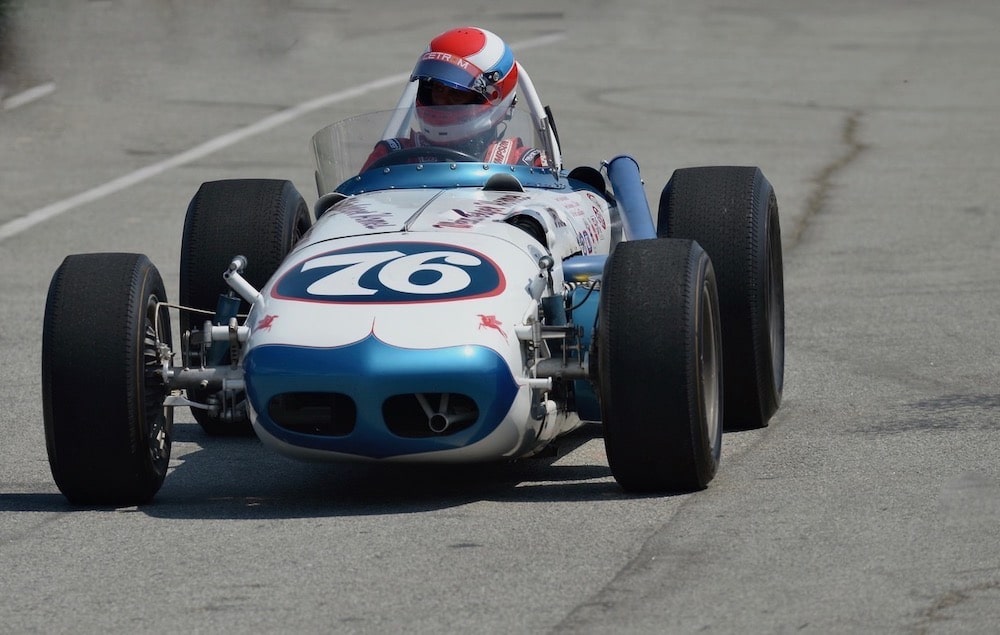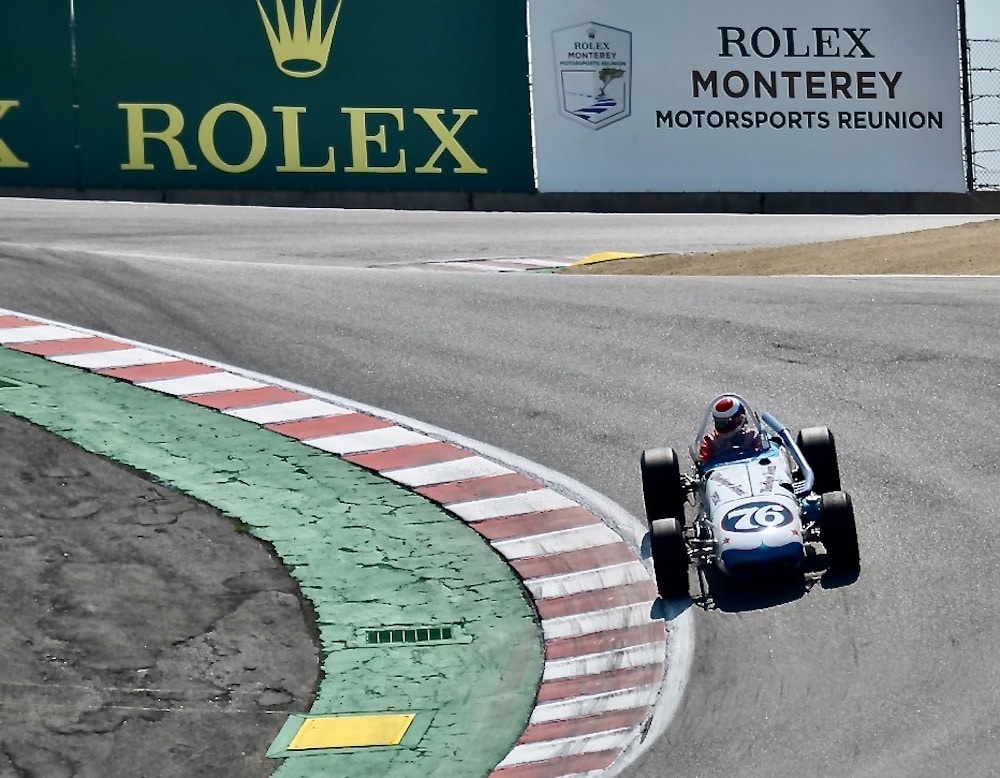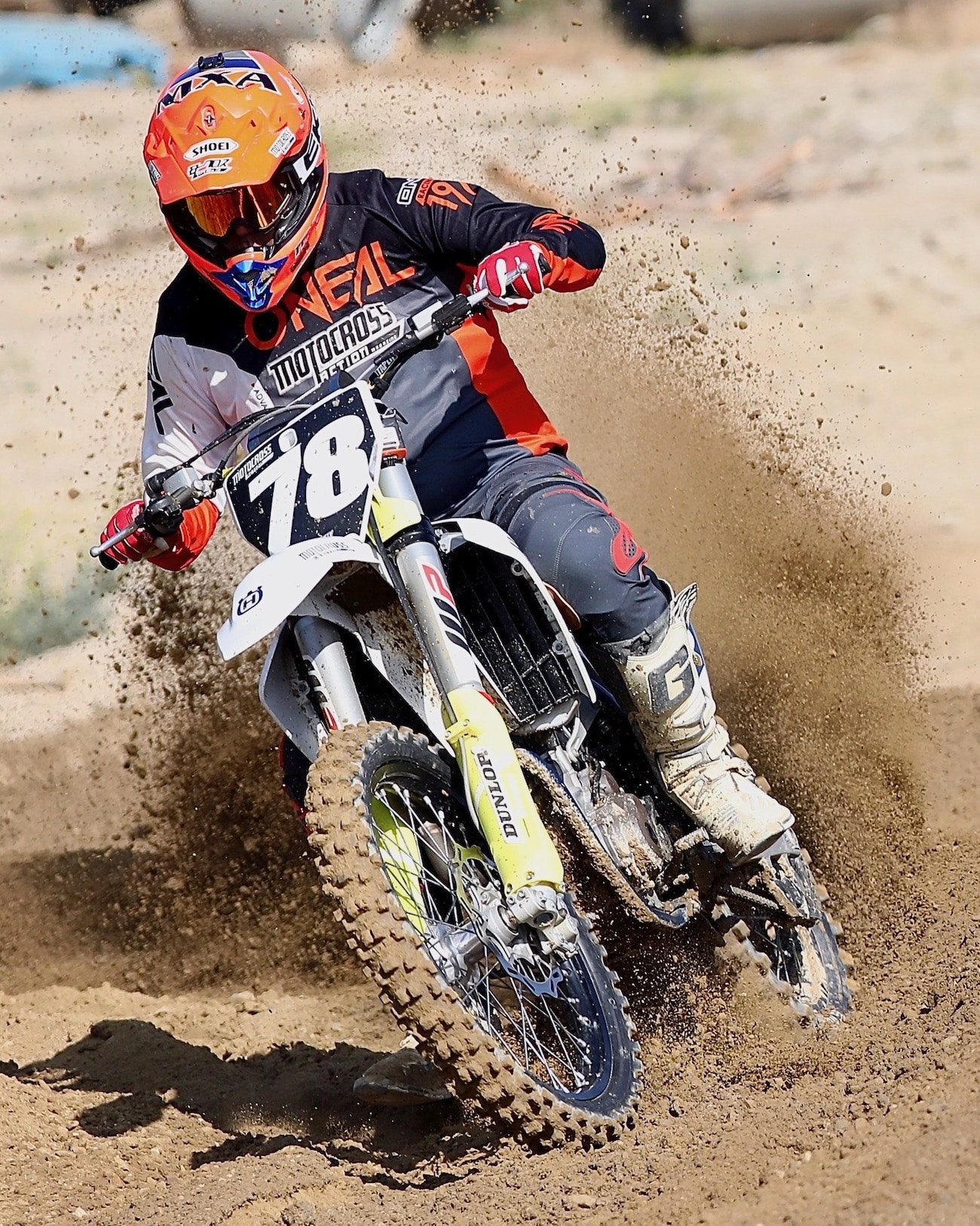MXA RACES A 1962 WATSON OFFENHAUSER ROADSTER AT THE 2021 MONTEREY HISTORICS REUNION

From the front the Watson looks smaller than it really is. In truth, Ernie’s helmet was a bigger part of the Watson’s aerodynamics than any part of the car.
Ernie Becker is a sports car driver by trade and a motocross racer on his off-weekends from the paved circuits. So, when he was offered the opportunity to race a classic 1962 Watson roadster at the 2021 Monterey Motorsports Reunion, he jumped at the chance and asked former and current MXA wrecking crew members Gary Jones and Dan Alamangos to go with him. Only three of these Indy roadster were built in 1962 by famed builder A. J. Watson (only 23 were ever built) and were driven by Jim McElrath to fifth at the 1962 Milwaukee 200 and 4th at the 1962 Trenton 200, Lloyd Ruby raced it to third place in the 1964 Indianapolis 500 and Gordon Johncock raced it to a fifth place finish in the 1965 Indy 500. This A.J. Watson roadster was the last front engine car to complete all 500 miles at the Indy 500. It is powered by a 253.5 cubic inch Offenhauser four with a two-speed Halibrand transmission. It qualified for the 1965 Indy 500 with an average speed of 155 mph. From here on, we will let Ernie tell his story of racing this 59-year-old warhorse.

Ernie Becker navigating the Laguna Seca Corkscrew in the front engine 1962 Watson Roadster.
“The car I drove at the Rolex Monterey Motorsports Reunion in the Indy Car exhibition races at Laguna Seca was one of the three cars built by A.J. Watson for the 1962 season. It’s priceless piece of Indy 500 history (a 1960 Watson Roadster sold for $577,500 eight years ago) and I was honored to be selected to drive this vehicle for the Malloy Foundation Collection. The owner, Tom Malloy, is an avid motorsports enthusiast and his companies, Trench Shoring and Ed Pink Racing Engines are activity involved in the automotive racing industry in many ways.

Gary Jones (World Vet T-Shirt), Ernie Becker (PCP Pro Circuit T-shirt) and Dan Alamangos (50th Anniversary “On Any Sunday” T-shirt) stand behind the 59-year old A.J. Watson-built Indy Roadster.
“What makes this car so special is that A.J. Watson built his frames using guidelines he laid out in chalk on the shop floor. Featuring a ladder frame, the 1600-pound Roadster was 32 inches wide at the rear and 29 inches wide at the front. Four torsion bars were used, two in the front and two in the rear. The pit crew could adjust the torsion bar’s tension at each corner to increase or decrease roll stiffness.
“A.J. Watson kept the Offy engine upright and concentrated on placing it as far left as possible. Which means 56% of the 1460-pound car was on the left. This was achieved by placing the Offenhauser engine six inches off the centerline of the chassis and the chassis was also offset an additional two inches to the left. The goal was to make the car turn left very efficiently.

Note the offset of the left and right-side wheels.
“The Meyer-Drake-Offenhauser engine was a double-overhead-cam, Hilborn fuel-injected, 16-valve, 253.5 cubic-inch four. USAC reduced engine size from 270 cubic inches to 255 cubic inches, which inspired Watson to develop a short-stroke 253 cubic-inch power plant that generated more horsepower than its 255 cubic-inch, long-stroke counterpart.
“The Watson Indy Car Roadster raced in four consecutive Indianapolis 500 mile races. The best finish was 3rd in 1964 with Lloyd Ruby driving. In 1965 Gordon Johncock drove the car to a 5th place finish and was the last front engine roadster to complete all 500 miles at the Speedway. The drivers in that era were a different breed. They knew the risks, all were competitive and they all wanted to win. They were total racers. And it makes sense, their families were from “The Greatest Generation” era.
 The transmission and drive shaft were next to Ernie’s left leg and the steering wheel was more tractor than race car.
The transmission and drive shaft were next to Ernie’s left leg and the steering wheel was more tractor than race car.
“Driving the Watson Roadster was like stepping back in time—all analog feel with no safety concerns whatsoever. It rumbled, backfired, shook while idling and it was loud! And when it backfired a fine mist of methanol sprayed through the cockpit and the scent made you really think you are going back in time. Paired with a two-speed Halibrand gearbox (with the drive shaft running right next to your leg) and sitting in an upright position with a two-foot wide steering wheel, comfort wasn’t even in question. But that was the normal for a Indy Car Roadster.
 From 1947 to 1964, every winner of the Indianapolis 500 was using an Offy engine, and in many of those years the entire podium was powered by Offenhauser. The “Big Four” Offy engines could make up to three horsepower per cubic inch, which remains an impressive figure by modern standards.
From 1947 to 1964, every winner of the Indianapolis 500 was using an Offy engine, and in many of those years the entire podium was powered by Offenhauser. The “Big Four” Offy engines could make up to three horsepower per cubic inch, which remains an impressive figure by modern standards.
“As you let the clutch out and got the car rolling, the engines revs began to build and the four-cylinder, mechanically fuel-injected, methanol burning engine began to smooth out. When it came awake, it accelerated like a WW2 fighter plane taking off for combat. The power delivery was solid, it accelerated very quickly and the throttle response was good. It asked you to push hard on the gas pedal to go fast. And back in the day it did. Gordon Johncock qualified for the Indy 500 with an average qualification time of 155.012 mph in 1965. Which means this old fighter was doing 180 mph down the main straights at the Indianapolis Moto Speedway. With your backside just four inches off the ground the sensation of speed was amazing—especially since there was little to nothing on or in the car for protection. Your upper torso is fully exposed and your head is part of the aerodynamics of the car. At max rpm, which for Laguna Seca was 5000 rpm, it still wanted to keep climbing in power.
 They don’t have Indy 500 cars in Australia, so Dan Alamangos wanted to get behind the wheel.
They don’t have Indy 500 cars in Australia, so Dan Alamangos wanted to get behind the wheel.
“Driving the car required pure-fighter pilot instincts. When you asked the car to do something, it responded like it should. The 1962 Watson Roadster was a fan favorite at the historics and my only assignment was to honor the car the way it deserved, which was being out on the track running it with a bit of anger. But since this car is priceless, I didn’t want to make a mistake and be the guy that wrecked one of the few running Watson Roadster on the planet. Plus, the car still had the tires on it that Gordon Johncock used back in 1965. By modern standards they were large circumference and small width. The 60-year-old rubber didn’t want to be pushed, which was understandable, so I babied it (keeping it under 100 miles per hour for the preservation of this incredible piece of automobile history and, of course, my own skin). The last thing I needed to do was throw a tread in the Corkscrew. However, you know your doing something right when 1986 Indy 500 winner Bobby Rahal pulls up along side of you down the straights, slows his late-model winged Indy car down, looks over at you and gives you a big thumbs up.
 Gordon Johncock at the 1965 Indy 500.
Gordon Johncock at the 1965 Indy 500.
“It was a weekend to remember. And have four-time AMA National Motocross Champion Gary Jones and Australian motocrosser and fellow MXA wrecking crew member Dan Alamangos as my guests for the weekend also made the Monterey Historics even more special. The only thing that was missing was my orange MXA helmet…maybe next time.
 Ernie Becker in action on his off-weekends from sports car driving.
Ernie Becker in action on his off-weekends from sports car driving.
“Special thanks to the Tom Malloy for letting me have the opportunity of a lifetime to drive this piece of motorsports history. Also a big thank you to the Trench Shoring and Ed Pink Racing staff. It takes a lot of support to keep one of these old fighters running. They went above and beyond the call of duty all weekend.”





Comments are closed.